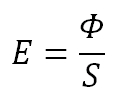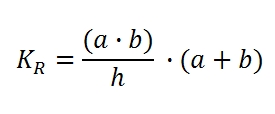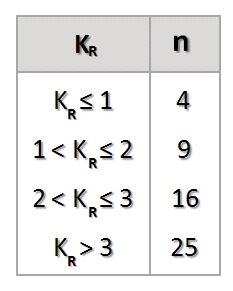
The average illuminance
Generally, when we talk about of illuminance we refer to the operating average illuminance Em, especially in the application of the levels prescribed by the regulations in force. This value is the average illuminance on the worktop in the environment considered, referring to an intermediate aging state and acquired during the ordinary lighting. Instead, in the generality of the measures, we tend to consider a series of illumination point which have no connection with the actual average illuminance of a given environment.
To measure the average illuminance you need to detect a certain number of illuminance points. This number must be sufficient for obtaining a mean value acceptable. You have to choose this number in relation to the dimensions of the room, the height of the worktop and the height of lighting fixtures.
The term illuminance, measured in lux, concerns a photometric magnitude which represents the ratio between the luminous flux Φ on a surface and the area S of the same surface, ie, the amount of light present on a given surface defined worktop (this surface is placed at 0.8 m above the floor at the workplace and at 0.2 m above the floor in the transit zones) and not the quantity of incident light on a possible observer.
In order to assess the amount of light that actually reaches the eyes you must also consider other variables such as luminance, illuminance of the retina, the light flux, glare. This factors also take into account both the reflective properties of the surfaces and the observer’s position as well as the illuminance itself.
Consequently the relationship between level of illumination and visual performance should be considered purely indicative, because, for example, a young subject needs of 200 lx for reading a document, whereas an elderly subject needs at least 600 lx.
Therefore the illuminance levels, necessary to define an optimal object visualization, can not be defined in absolute. This is not only because the reflection coefficients of the walls and objects can change the illuminated visual perception, but also because each individual has different reactions to the stimulus of light.
Often during my work experience, either as a consultant or as a result of investigations and complaints, I found myself having to detect or verify the level of average illuminance of a given environment (banks, shopping malls, stores). Precisely for this reason I have always applied and been able to verify the usefulness of the simple and practical procedure described in this article.
Description of the method
First, you need to calculate the coefficient of detection KR of the environment, using the following formula:
-
- a = length of the room in meters;
- b = width of the area in meters;
- h = distance in meters between the lighting fixtures and the plane on which you have to measure illuminance (eg height of lighting fixtures 2.80 m, worktop at height 0.8 m, h = 2.80 to 0.8 = 2).
Once you have obtained the value of KR, you can determine the minimum number of measurement points “n” using the following table:
n represents the number of zones needed for carrying out to measure the illuminance. The sides of each zone are obtainable by applying the following formula:
-
- a = length of the room
- a1 = length of the measurement zone
- b = width of the room
- b1 = width of the measurement zone
- n = the number of measurement zones
If a1 is higher than the double of b1, you have to proceed by trial and error increasing the n number of measurement points, respecting the following conditions:
-
- a1 ≤ 2·b1;
- a1/b1 ≤ 2;
- zones with larger side ≤ 2·zones with smaller side.
Once you have determined the minimum number of measurement points, you can start to identify the points of measurement and then to the actual measurement, but not before the sensor of the luxmeter has been exposed to the ambient lighting for at least 5 minutes.
The measures must be carried out without the contribution of other light sources and you need to verify the value obtained with small displacements around the point of measure chosen (15/20 cm) being careful not to position directly under any light source. If you have to measure on a worktop such as a desk or a counter in a shop, you must to keep the measuring sensor up for at least 3/4 cm from the surface and not placed directly on it.
Should be noted that the procedure just described, identifies the minimum number of measurement points so that the value of average illuminance can be considered acceptable; therefore it is advisable to increase the number of the measurement points rather than to decrease them, especially when you are performing the measure in particularly complex environments or with the purpose of a more reliable detection.
Practical examples
Example 1
The room size is 20 x 15 m, the distance h between the lighting fixtures and the working plan surface is 2 m, the height of the worktop is 0.80 m; is R = (20 x 15) / 2 x (20 +15) = 300/70 = 4.3; it requires a minimum number of 25 measuring points with areas of sides a1 = 20/5 = 4 m b1 = 5/15 = 3 m. Since the greater side a1 is not longer than twice the smaller side b1, the relationship between a1 and b1 is less than 2, the number of zones on the longer side is less than twice that on the smaller side; the number of 25 zones (5×5 with a1 = 4 m and b1 = 3 m) can be considered acceptable.
Example 2
The room size is 15 x 4 m, the distance h between the lighting fixtures and the worktop is 2 m, the height of the worktop is 0.8m; it turns out that R = (15 x4) / 2 x (15 +4) = 60/38 = 1.6, thus, it requires a minimum number of 9 measuring points with zones of side a1 = 15/3 = 5 m and b1 = 4/3 = 1.33 m. Since the greater side a1 is greater than twice the smaller side b1, the number of zones must be increased. Through a series of subsequent calculations we get a subdivision that may be considered acceptable: 32 zones (8×4 me with a1 = 1.88 b1 = 1 m).
Analysis of the results
The average illuminance Em is given by the arithmetic mean of the illuminance values measured at the center of zones:
-
- Em = average illuminance
- E1 ÷ En = illuminance values of the measured points
- n = total number of measurement points
Once you obtained the value of th average illuminance Em , you can assess the uniformity of illumination by the ratio Emin / Em. Particularly the ratio Emin / Em must not be less than 0.8, whereas in case of adjacent rooms, the average illuminance Em of the more enlightened room must not be greater than 5 times that of the room with the average illuminance Em lower. In addition, the average illuminance Em, measured in areas where you perform tasks that do not require visual effort, should not be less than one-third of that present in the areas where these activities are carried out.
Presentation of the measurements
In order to make the determination of the illuminance more reliable and professionally valid, it is appropriate you present the results obtained with the appropriate technical report, including a description of the method used and all measurement tasks. Finally we have to add the following attachments:
- detailed photographic documentation of the room and measuring points;
- technical documentation of lighting fixtures and instrument used for the measurements.







